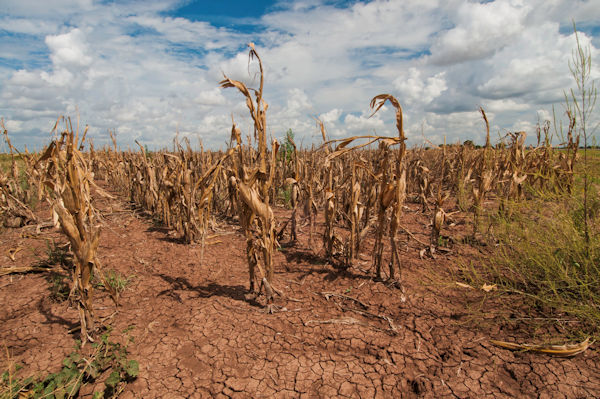SEJournal Online is the digital news magazine of the Society of Environmental Journalists. Learn more about SEJournal Online, including submission, subscription and advertising information.
 |
| The author makes the case for reporters to cover local stories of drought and climate change more consistently. Above, corn shows the effect of the drought in Texas in 2013. Photo: Bob Nichols/USDA, Flickr Creative Commons (CC BY 2.0). |
Feature: Going Beyond Sensational Drought Headlines Gives Local Audiences News They Need
By Laura Paskus
Periodically, dramatic stories about megadrought or precipitously dropping reservoir levels in the western United States make waves in the national press, often spurred by newly published articles in peer-reviewed journals like Nature Climate Change or via the release of federal data or reports.
Bringing news about the science and policy surrounding western drought to a national audience is imperative, especially when it comes to raising awareness among congressional delegations, policymakers and political candidates.
But it’s just as important — OK, I think it’s even more important — for reporters to consistently cover the local stories of drought, aridity and climate change within their own communities.
Drought has doggedly moved around the southwestern United States since 2000, triggering cumulative impacts ranging from wildfire to decreased agricultural yields.
Reporters can be just as persistent, translating the science for local audiences so people understand natural variability, as well as how drought and climate change are tied together — and holding local and state officials accountable when it comes to preparation and planning.
It’s not enough to simply jolt audiences with
alarming headlines a few times a year. It's the
consistency of coverage that truly matters.
It’s not enough to simply jolt audiences with alarming headlines a few times a year. The sort of community- and state-level change that’s so clearly necessary for mitigating and adapting to climate change requires consistent follow-up and context.
There are so many conversations about how to cover climate and environment news — for example, whether to avoid “doomism” and focus on solutions — but I argue that it’s the consistency of coverage that truly matters.
In the West, drought is an everyday experience for both urban and rural residents and should be treated as such in the local media. The same goes for climate change, its causes and impacts alike.
Detailed information adds context, empowers audiences
In my perfect world, information about soil moisture, streamflow, reservoir levels and how today’s conditions compare with those of the past would be integrated into ongoing drought coverage, local weather forecasts and daily news stories.
There’s no good reason, for example, for broadcast meteorologists and weather forecasters to avoid talking about climate change and long-term drought during their daily forays into people’s living rooms and smartphones. (In this episode of NMPBS’s Our Land, Phoenix meteorologist Jorge Torres offers solid advice for those who want to do so.)
Providing that context is a key public service that educates audiences and provides them with the information they need to make good decisions — whether those decisions involve choosing which crops to plant, integrating water and land use planning at the city or county level, or tracking how state legislatures are funding things like water planning and the agencies that manage and regulate natural resources.
Fortunately, local reporters have access to plenty of government and academic resources that make it easy to help audiences understand long-term drought’s impacts in a climate-changed world and incorporate information about historical, current and future conditions into their daily lives. These include:
- NOAA Climate.gov: Links to forecasts, maps, data, climate summaries and more.
- NOAA's National Integrated Drought Information System: A multi-agency partnership that focuses on drought monitoring, forecasting, planning and information at federal, tribal, state and local levels. You can enter your zip code and get localized drought impact information. NIDIS also holds regular regional drought briefings and webinars on forecasts, as well as topics like soil moisture.
- U.S. Drought Monitor: Weekly updates for regions and states, with data on how current conditions compare with past conditions, weekly drought summaries and all sorts of maps, including the option to customize a map request.
- Natural Resources Conservation Service’s National Water and Climate Center: Includes the Snow Survey and Water Supply Forecasting Program for western states and the Soil Climate Analysis Network Pilot Program. You can also look at current conditions for precipitation, streamflow and snow water equivalent.
- U.S. Bureau of Reclamation River Basin Tea-Cup Diagrams: Valuable, basin-specific information about major reclamation reservoirs throughout the Upper Colorado Region.
- USGS National Water Information System: You can search for current and historic data on surface water, groundwater, water quality and water use. I have the USGS Current Water Data for New Mexico site bookmarked and also subscribe to daily alerts on important water gauges in my state, such as on the Rio Grande and the Gila River. These alerts help me keep track of stream flow fluctuations when I might be paying attention to other stories. (To subscribe, find the gauge you’re interested in and scroll down to “Subscribe to WaterAlert.”)
People from all walks of life also have experiences and knowledge to share, gained from dealing with the impacts of drought on their farms, in their neighborhoods and at their schools. Reporters can learn from elders about past conditions and ask young people to offer their visions of the future.
Stories about drought must also reflect the diversity of western communities and highlight not only the hardships communities face but the knowledge and expertise they bring to the table.
A story too big for just one reporter
In the western United States, the news of drought and climate change can be overwhelming. Writing about drying rivers, dropping reservoirs, threatened and endangered species, struggling farmers, scared or enraged communities, alarmed scientists, overwhelmed regulators or managers, and tapped out cities and towns takes a toll on reporters.
But one of the things that brings me comfort, as a reader and a reporter, is the stalwart presence of local reporters covering drought and climate change throughout the region.
The work that each of these reporters is
doing within their own communities and
at their own outlets strengthens all of us.
Some of us know one another personally, having overlapped at news outlets, shared time in the field as IJNR fellows, met one another through the Society of Environmental Journalists or Zoomed into the same webinars and talks. But even if our paths have never crossed directly, the work that each of these reporters is doing within their own communities and at their own outlets — building trust and pursuing local angles — strengthens all of us.
I know, for example, that if my New Mexico audience needs to better understand what’s happening elsewhere in the West, I can share the work of Ian James and Sammy Roth at the Los Angeles Times; Brandon Loomis, Deb Krol and Arlyssa Becenti at the Arizona Daily Republic; Daniel Rothberg at The Nevada Independent; and Tony Davis at the Tucson Daily Star.
Locally, I can point our audience toward work by the growing number of reporters incorporating climate, water, energy and wildfire coverage into their daily coverage in New Mexico.
The story of drought in the West is big. Too big for one reporter. Too big for one headline. But I’m confident that the more local reporters dig into the story of drought and what it means for their western communities, the more effectively we can all build on an important regional story together.
A longtime journalist, Laura Paskus is currently the environment reporter at NMPBS and serves on the board of directors for the Society of Environmental Journalists. She’s also the author of “At the Precipice: New Mexico’s Changing Climate,” published in 2020 by the University of New Mexico Press.
* From the weekly news magazine SEJournal Online, Vol. 7, No. 22. Content from each new issue of SEJournal Online is available to the public via the SEJournal Online main page. Subscribe to the e-newsletter here. And see past issues of the SEJournal archived here.












 Advertisement
Advertisement 



